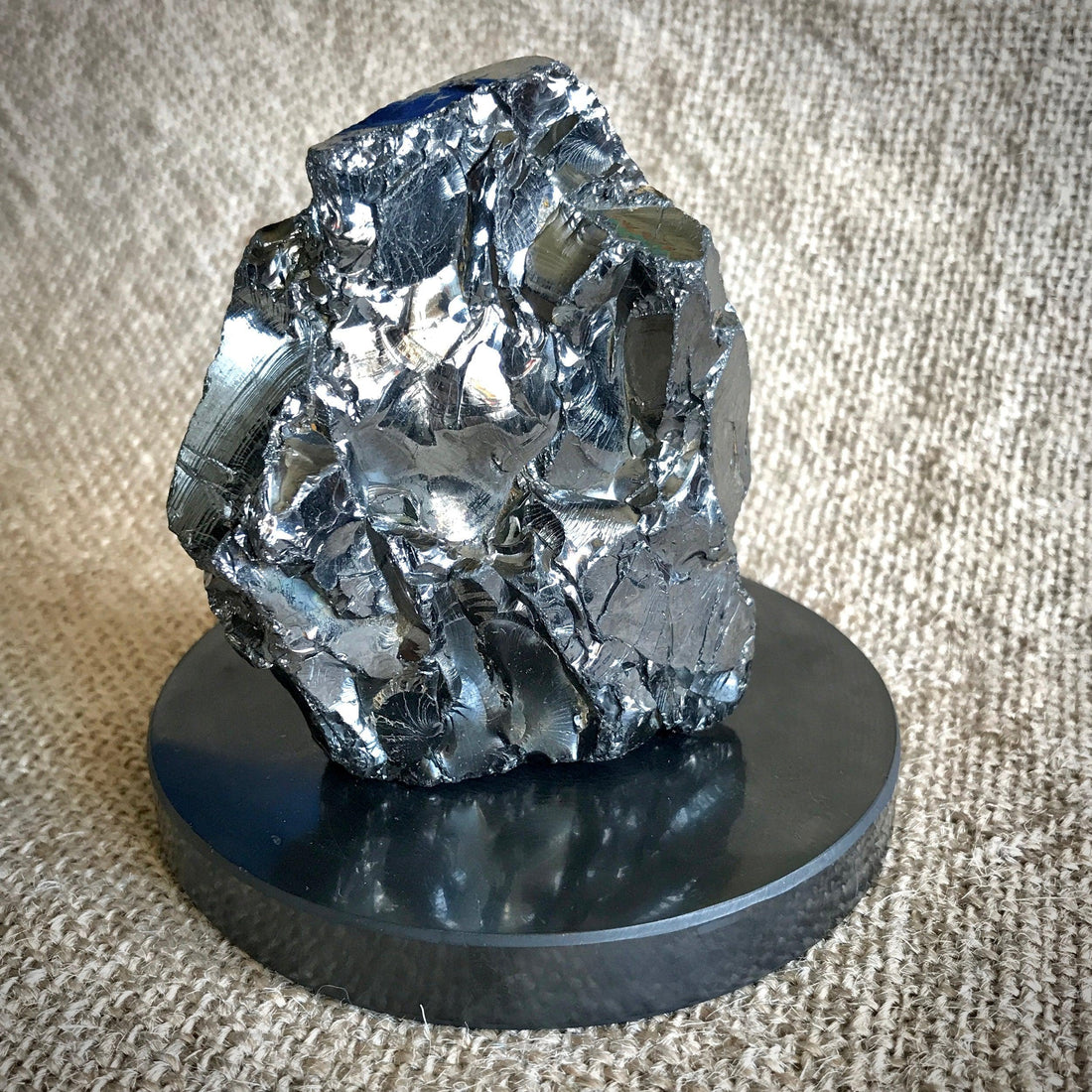
Shungite 101
Valerie BurkeHave you heard of this rock called shungite but don’t know much about it?
Maybe you have a piece of shungite, and someone just asked you about it but you don’t know what to tell them. If so, then is article is for you!
Below is a basic shungite primer that you can easily share with anyone who wants a little introduction to this amazing EMF protective stone.
1. What is Shungite?
Shungite is the only naturally occurring mineraloid with a body of science to support its EMF mitigating properties. This special stone's unique molecular structure and distinctive electromagnetic properties give it unparalleled health benefits.
There is only one outcrop of shungite on planet Earth, which is in Karelia, Russia. Karelia is on Russia’s northwestern border with Finland. No other carbon-based rock in the mineral kingdom is like shungite!
Based on current estimates, shungite may be completely mined out in within the next few years. The higher grades are becoming increasingly rare, and prices have risen significantly - especially for the larger pieces and for top grade shungite, called “elite shungite” (aka noble shungite or type 1).
2. How was shungite formed?
This special stone is the oldest known hydrocarbon-based rock on Earth, dating back more than 2 billion years. As stated above, there is only one known outcrop on our planet - in Karelia, Russia. Even though shungite’s composition is similar to other carbon-based rocks such as graphite and diamond, its structure and properties are so rare and distinctive that scientists cannot agree on how it formed.
Shungite’s genesis probably began much like shale since it began in an era when the earth was populated by single-celled organisms. These organisms accumulated and mixed with mud and silt on the bottom of a body of water.
After that, substantial forces of heat and pressure transformed these organic materials into rock, but it’s the source of these that remained uncertain. Some believe it was geothermal heat and compression. Others believe it was an asteroid impact. Others have postulated that shungite is extraterrestrial altogether, because it appears nowhere else on Earth.
3. What is shungite made of?
Shungite is made of dozens of minerals and elements, one of which is carbon. Some of the carbon is in a highly unique molecular form called fullerenes - structures resembling soccer balls. It is believed that these fullerenes are responsible for many of shungite’s health benefits. The different subtypes of shungite are based on the amount of carbon present.
Shungite dates back two billion years to a time when our planet was populated by single-celled organisms. Just as with shale and slate, shungite started with these organisms accumulating and mixing with mud and silt on the bottom of a body of water. Geothermal heat and compression slowly transformed these organic materials into rock.
Because of its conditions of formation, shungite also contains a diverse complement of silicate minerals, iron, titanium, magnesium, potassium, calcium, sulfur, aluminum, and a wide variety of other natural elements.
4. What are the benefits of shungite?
Simply put, shungite can transform EMFs (electromagnetic frequencies) into wave forms that are more biologically compatible with our bodies. For centuries, Russians have been using shungite to treat everything from allergies and infections to inflammation, traumatic injuries, high blood pressure, osteoarthritis, digestive maladies, skin conditions - even depression.
Shungite has antioxidant, anti-inflammatory, antiviral, antibacterial, antifungal, and detox properties, in addition to helping the body manage the harmful effects of both ionizing and non-ionizing radiation. It has been reported to provide relief from a variety of skin conditions, as well as boosting our resistance to illness and assisting our bodies with detoxification.
It is shungite’s unusual molecular structure that makes this all possible. Within its mineral matrix are huge hollow carbon structures resembling soccer balls, termed fullerenes (or “buckeyballs”), which were named after the late Buckminster Fuller who was famous for his geodesic dome architecture.
Fullerenes are basically molecular hexagons and pentagons bound together into hollow cages. These fullerenes give shungite a high oxidative and reductive capacity. Think antioxidants!
Fullerenes are so important that in 1991, Science magazine distinguished fullerenes as the “molecule of the year,” and in 1996 the scientists who synthesized them were awarded the Nobel Prize in Chemistry.
Ever heard of carbon 60? Shungite has it – and more. Shungite houses seven types of fullerenes containing between 24 and 70 carbon atoms, but it’s really only the larger fullerenes (60 and 70 carbons) that are so special. Fullerenes with 60 carbons are known as carbon 60 (C60), whose health benefits have been recently revealed.
Shungite is known for a variety of health benefits. It is best known for its ability to help people with electrohypersensitivity by transforming the frequency of manmade EMFs (electromagnetic radiation) into more biologically compatible frequencies, thereby neutralizing their impact. Many people who suffer from electrohypersensitivity report benefits from shungite – but its benefits don’t stop there.
In addition to helping mitigate the effects of both ionizing and non-ionizing radiation, this amazing stone can help us stay grounded, calm and connected to the world around us. Shungite is able to support us on all levels - physical, emotional and spiritual.
5. How does shungite protect from EMFs?
Energetically, shungite has been found to expands our “vital field.” Shungite researcher Regina Martino found shungite to be the only rock or mineral able to realign the chakras and optimizing this vital field. Specifically, it strengthens the vitality of the first chakra (root chakra), which is directly connected to our health and vitality.
A common misperception is that shungite blocks or traps EMF, but this is not how it works. Shungite actually “transforms” them, changing their wave forms such that their damaging biological effects are neutralized. Shungite makes those health-disrupting, DNA-twisting, manmade EMFs more like the Earth’s natural fields - which are compatible with our bodies.
Please note that this is not something that can be measured with an EMF meter, because the EMFs are being transformed, not absorbed or filtered out.
It’s all about resonance.
Many people report feeling better when they have shungite around them. In her book Shungite: Protection, Healing, and Detoxification, years of experimentation led bioenergetics researcher Regina Martino to conclude that having shungite around you greatly reduced the negative effects of EMFs.
Shungite’s capabilities are equally impressive when it comes to ionizing radiation. A 2017 study showed how a topical shungite preparation protected hairless mice exposed to UVB radiation. Similarly, a Ukrainian study found that rats exposed to radiation and given shungite water for 15 days showed a 95 percent survival rate, compared to 63 percent for the control group.
6. How can shungite be used?
Shungite stones can be worn on your body as jewelry or placed around your home and workplace. You can position shungite pieces around a room, especially in your sleep sanctuary and other areas where you spend a lot of time.
The larger the mass of shungite, the farther its range. Shungite is available in sculptural forms, such as spheres and pyramids – and happens to be as beautiful as it is functional!
Elite shungite can be used to make shungite water, which can be ingested or applied to the skin.
As with most things, there's a good deal of misinformation circling the Internet. As shungite gains recognition, fake shungite products have emerged in the marketplace. I test all my shungite for authenticity. If you want to test shungite for yourself, here is my video about how to do so using a simple multimeter.
7. Can shungite get wet?
As a stone, shungite can get wet. Although shungite is a soft stone, it will take many years for it to degrade in the environment. Elite shungite (the form highest in carbon) is even used to make a shungite-infused water, commonly called “shungite water.” However, when it comes shungite jewelry, water exposure is another story.
I don't recommend letting your shungite jewelry get wet. Water can seep into bead and pendant holes and quickly degrade other jewelry materials, such as leather cording. It can also dull the luster of polished shungite. Therefore, it is best to remove shungite jewelry before showering or swimming so that it is not exposed to water.
8. Where can I find more information?
For help in getting started with shungite, this post may be helpful.
Many of your most commonly asked questions are answered on my FAQ page.
If you want to read a comprehensive report about shungite, my 2018 report Shungite: The Electropollution Solution, is available as a free download.

